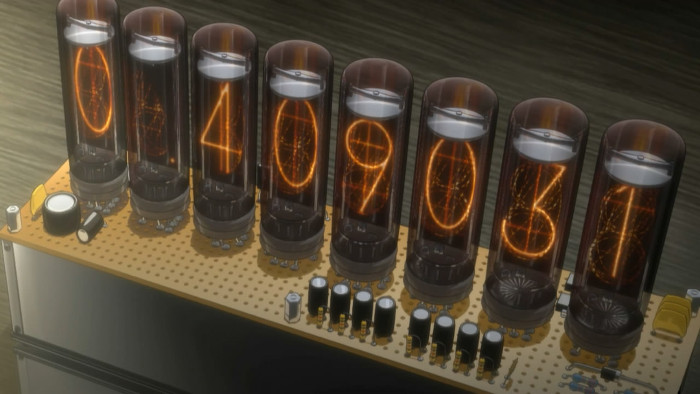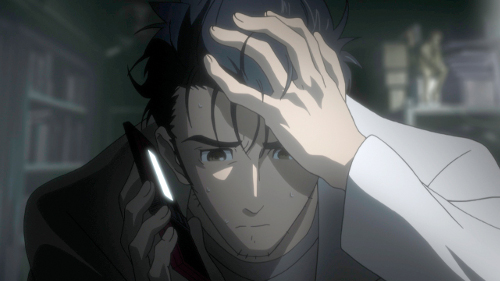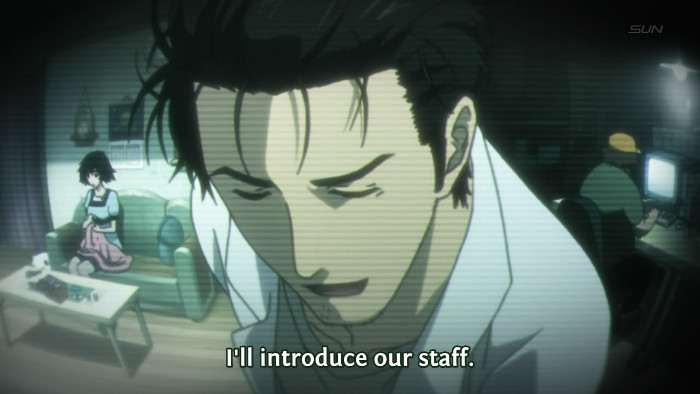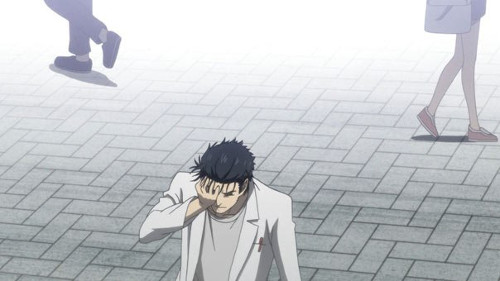The Organization has infiltrated my lab and is trying to lure me into a false sense of security. My work can’t be discovered. Read it before I’m forced to purge its contents. And most importantly, remember the code words!
Title: Shutainzu Gēto (Steins;Gate)
Original airing: Apr 6, 2011 to Sep 14, 2011
Studio: White Fox
Episodes: 24
Duration: 24 min/episode
Genres: Sci-Fi, Thriller
Source: Visual Novel developed by 5pb/Nitroplus
Where I watched: Funimation (english sub) and Blu-Ray discs (english dub and sub)
Brief Synopsis and First Impressions:
The microwave is a time machine. Okarin proved it. The self-anointed mad scientist nuked bananas into some gelatinous version of the future. Or maybe it was the past. Doesn’t matter. No one thought he could do it, but he did it anyway. He sent text messages through time to people he knew. To his friends. Some of them female. Pretty. He should have been more careful. He should have stopped. Tampering with the time-space continuum attracts unwelcome attention. Clandestine organizations of nefarious origins take notice. SERN. Always watching. Okarin knows; he can feel their eyes. That’s why he started the top secret Future Gadget Lab. To stop them. You should join. We get to wear lab coats, and it’s dangerous. Danger is exciting because it’s deadly. The microwave is a time machine.
Credit: Funimation
Wow. What even is that description? Thanks Funimation, for making the series sound absolutely bonkers. MyAnimeList’s premise is a little more reasonable, but this one highlights something about the series. Sounding like the ramblings of a mad scientist, this series features one that lives up to the stereotype in many ways. Steins;Gate is a little bit crazy when you get right down to it. Lab coats, time-travel, and a very thinly veiled parody of a popular scientific organization bent on world domination. It even has a title that they never really explain the meaning of.
I had little idea as to what this series was when I got into it, but given the theme my initial interest was already piqued. Time travel is a tricky theme to do properly, but when a story does it right it can be a compelling and rewarding experience. I’ve only come across a few stories that managed to do this, as they often fall victim to inconsistent rules or poorly explained phenomena. Ever the optimist, I was eager to find out if this one would deliver a unique and satisfying story or play out the same tired cliches of so many others before it.
Story

Steins;Gate is a show about time travel. This statement is meant to be taken in a literal sense. It’s not a series where time travel simply happens or serves as a vehicle for the characters to drive the plot. Though there are definitely human elements to the story, the series itself is about travelling through time and all the consequences that can arise from it. Familiar elements such as the butterfly effect and the grandfather paradox are explored, but the series goes to great lengths to define time travel in a way that allows it to be internally consistent and accessible to viewers.
The story centers around a small cast of characters working at a very amateur level on what can best be described as ‘general science.’ The Future Gadget Laboratory, run by Okarin and his two friends out of a small second floor apartment in Akihabara, has seen several odd and questionably useful inventions. His obsession with the concept of time travel has led to their greatest invention yet: Future Gadget #8: ‘Phone Microwave’ (temporary name). Using it to unwittingly come across a means by which time travel is possible, the group gives in to their curiosity and begins a series of seemingly harmless experiments to test the limits of their invention.

The series spends a fair number of episodes on the ‘experimental’ phase, allowing time for viewers to be introduced to new characters and delve a little deeper into the thoughts and motivations behind the cast. Their initial tests involve sending short messages into the past. These messages start out by making small alternations to the timeline, but soon spiral into reality altering changes. What begins as harmless experimenting soon turns into an out of control situation as more and more people begin tampering with time and the activities of the lab are noticed by other troublesome parties.
The butterfly effect is a well known concept when it comes to time travel stories as it has become a staple of the genre. The unintended consequences as a result of one’s actions in the timeline are a typical source for drama in these types of stories and Steins;Gate is no exception. It relies heavily on the idea of consequence to drive the majority of its story and attach emotional weight. But to keep things fresh and interesting it employs another element with the theory of world lines. Put simply, any action taken in a given timeline spawns one of an infinite number of timelines separate from one where that action did not take place. Peoples’ actions, therefore, create an infinite number of world lines that allow diverging realities to exist simultaneously. What complicates this phenomenon is the concept of world line convergence. Certain events in converging world lines take place no matter what else changes.
This idea introduces a true struggle in the story’s narrative and avoids the question of why the characters cannot simply use time travel continuously to erase their mistakes. There are no arbitrary restrictions like running out of fuel for the flux capacitor that keep the characters ‘stuck’ with a given problem. They are simply unable to prevent certain events due to the way convergence works. Unwilling to accept one such inevitability, Okarin makes several attempts to shift his world line to one that doesn’t contain this event.

Without going too far into spoiler territory, the series contains enough suspense and drama to hold viewer interest – that is, if they make it far enough to get to the truly interesting points. The slow start, though necessary to build out the rules and limitations of the time travel aspect, can be a little tedious. Similarly, the almost slice of life nature of the character interactions at first leave the show without a clear focus. Exacerbated by Okarin’s seemingly incoherent and unsubstantial ramblings that begin from the very first episode, the series can feel a little hard to approach.
Persistent viewers will see, however, that the aforementioned ‘event’ forces the series to focus on one particular goal. The real substance of the character development and story progression takes place around this segment and imparts most of the lessons that the series is trying to convey. Far from wasting the first half, the conclusive arc ties together everything that took place before. The end result is a truly cohesive story that wraps up the individual character threads like converging world lines.
Characters

As a visual novel adaptation, I wasn’t sure exactly how this series would handle its characters, as I hadn’t seen one before that I’m aware of. These sorts of games focus on a scripted set of events with various branching narratives available for the player character to explore. Trying to fit all these arcs into one anime is certainly a tough challenge, and while I am unfamiliar with the game, I was impressed at how organic some of the characters in Steins;Gate felt. Each character has a distinct personality and almost all of them have more depth than their initial archetypes let on. Adding to their individual personalities the series is full of witty back and forth banter, allowing viewers to learn about their nuances in a creative and comedic way.
The focal point of the series is Rintarou Okabe. Preferring to be called by his mad scientist name, “Hououin Kyoma” (though we’ll stick with Okarin for this review), his quirky phrases and penchant for slinging conspiracy theories paint him as a seemingly paranoid and unhinged person. Though he seems well versed in scientific theory regarding time travel, it is difficult to tell whether or not he possesses any actual brilliance beneath the act. What does become clear is that his behavior is an act, as his playful banter dies down steadily over the course of the series. As each time altering event takes place, Okarin grows more introspective and worried. Being the only one who manages to keep his memories in tact across time jumps (thanks to an unexplained ability he dubs “Reading Steiner”), he alone understands the gravity of what is taking place.
While time altering events seem to erase the other character’s memories of the world line where the event didn’t take place, they aren’t completely oblivious to the subtle changes. In particular, Okarin’s innocent follower Mayuri Shiina notices the changes in his behavior most readily. Perhaps it is the result of her knowing him for years prior to the series or her innate empathy, but she becomes one of the first to counsel against fooling around with the timeline. Having no scientific merit of her own limits her effectiveness in this task, but more often than not she guides Okarin’s thoughts and actions to remind him of the human element in his dangerous experiments.
The scientific counterpart to Mayuri’s emotional characterization is provided by Kurisu Makise . Rivaling Okarin’s intellect, her expertise becomes vital in helping the team figure out exactly how their machine works and what they can do with it. She comes to the group after a fateful encounter with Okarin at the beginning of the series and reluctantly puts up with him (and others) in order to further her own scientific curiosity. She possesses more similarities with Okarin than she cares to admit, however, and by working alongside him throughout the series they come to form and otherwise unexpected bond.
Animation

Lacking the imaginative style of Katanagatari or the fantasy elements (and relative newness) of Akame ga Kill!, Steins;Gate cannot claim the same attractive visual style that some other White Fox projects have. The series doesn’t aim for any particularly stunning visual displays; as it portrays a mostly realistic setting and simply designed characters in the middle of Akihabara. Still, it remains decent and consistent in every episode.
Considering that this came out alongside Anohana, another anime with simple designs, it could have been possible to make the animation appear more crisp or the style more visually attractive. Given how similar many of the scenes appear to the visual novel, it’s adaptation is likely the reason why the anime looks the way it does. With plenty of shots that show characters’ faces in the center of the screen and speaking into the camera, it leaves little wonder as to where the art direction is drawn from.
One interesting point to note is the way that lighting is used in both indoor and outdoor scenes. Okarin’s apartment scenes occur mostly in the middle of the day and make use of natural light filtering through the windows. Outdoor scenes, on the other hand, are bathed in a very bright white that looks as if the city is being baked under a lamp. It’s a style that doesn’t seem to be lifted from the game, so I’m not entirely sure of the reason they chose to use it. Though the effect could possibly be typical of an August day in the middle of Tokyo, it does stand in stark contrast to the indoor or night scenes.

Numerous time travel scenes feature a shaking camera and indistinct backgrounds behind a set of bright numbers (which clue in the viewer to how much of a change a particular event caused). Scenes showing the phone microwave also often have electricity arcing wildly before the time shift takes place. The lack of visual detail during the actual jump may have been deliberate to convey its disorienting nature, but feel a little generic. If the animators had wanted to, they could probably have made this phenomenon look a little more vivid.
Sound

OP: Hacking to the Gate by Kanako Itou
ED1: Toki Tsukasadoru Juuni no Meiyaku by Yui Sakakibara (eps 1-21)
ED2: Fake Verthandi by Takeshi Abo (ep 22)
ED3: Sky Clad no Kansokusha by Kanako Itou (ep 23)
ED4: Another Heaven by Kanako Itou (ep 24)
Drawing three ending themes from the visual novel, Steins;Gate continues its homage to the popular source material. These unique endings accompany the final arc of the series, as each of the last three episodes is meant to be impactful and could work as endings on their own. The title of at least one, however, should clue the viewer in to the fact that the series doesn’t really end at that point. The opening and the first ending were specific to the anime and, despite not coming from the game, they fit the anime very nicely.
Hacking to the Gate is especially catchy with its strong electric guitar and energetic chorus vocals. Toki Tsukasadoru Juuni no Meiyaku is also catchy, but is a much more flowing and somber song. For BGMs, nothing stands out more than Gate of Steiner. One of the most iconic representations of the series, it comes from the visual novel and sounds very much like Fake Verthandi. Both songs have a mysterious feel to them, but one that suggests action as well.
Voice acting is top notch, no matter what language you hear it in. Having played in so many well known titles before and after, Mamoru Miyano is simply amazing at giving life to Okarin no matter what tone of voice he’s speaking in. Even the various heavily accented English phrases that he uses sound entertaining, especially one well known scene.
If any of you have read some of my other reviews, you will know how much of a sucker I am for good Funimation dubs. Steins;Gate was no exception, somewhat unsurprisingly choosing the writer for the English script, J. Michael Tatum, as Okarin. He does a fantastic job, even if I was a bit thrown off to hear Ouran Host Club’s Kyoya senpai spouting out nonsense about the Organization or his goofy Norse codenames.
Overall Appeal
Starting with the imposing challenge of adapting the unique storytelling format of a visual novel into an anime, Steins;Gate offers a remarkably well done final product. As I mentioned in the Characters section, these types of games often feature several character arcs for the player to complete. Some of these can be side stories while others coincide with the main plot. In either case the somewhat disparate arcs, romantic and otherwise, don’t always mesh together well when trying to form a single cohesive story. This series, however, does exactly that.
Using its theme to the fullest extent, Steins;Gate is able to infuse all these threads into one single story in a way that makes sense. More than that, each one represents an important event in the course of the overall story. With the exception of perhaps one character, the viewer can find significance in the journey that the series takes with each one. Usually one episode is used to present the character and the time altering decision they wish to make, and another episode to revisit it in reverse order. It helps to tie the entire series together in a way that might not have worked if the major theme was not time travel. Without knowing a lot about the visual novel I can’t say whether this tactic was borrowed as well, but in any event it plays out masterfully when the anime is considered as a standalone work.
The other major hook of the series is the well done love triangle that forms as the series progresses. While the adaptation may lend itself to some harem-esque qualities, viewers soon come to see two relationships in particular taking shape. Far from using it as an overdone tactic to insert drama into a narrative that could have otherwise done without it, these relationships become the focal point of Okarin’s decisions throughout the series. Furthermore, his choice has real lasting consequences as keeping one means dire consequences for the other. The anguish he has to endure over making this choice is certainly one of the series’ more gripping elements.
Summary and Recommendations
Steins;Gate offers a refreshing take on the time travel genre by presenting a series that is actually about time travel. Using real world analogues and popular hypotheses about time travel that have sprung up in scientific circles, it presents interesting concepts that can draw interest from science fiction fans on this point alone.
Without stellar animation or a large budget to support it, the appeal of the series is heavily reliant on its narrative. The show carefully defines how time works and adheres to the limitations it sets forth in its explanations, thereby allowing the viewer to better understand how and why the characters decide to act. The inevitability of certain events creates a dramatic twist which drives much of the story progression, but makes the journey toward overcoming that inevitability believable.
A small set of well defined characters helps make up for the lack of development in others, primarily using their experiences to guide the viewer through the story. Okarin especially is an intriguing character to watch, as seeing him descend into despair when the outcome of his efforts end in disaster makes for a compelling narrative. This is made all the better when his friends shows can help show him a way out.
As a visual novel adaptation, a few things may pop up which allude to common tropes found in such games. While not technically a romance anime, there is a love triangle that genuinely feels like it could go either way. Serving as much more than romantic filler, it represents the dire choice that secretly lurks at the heart of the series.
Watch if you:
Enjoy time travel stories
Like intricate plots
Can enjoy a slow buildup to dramatic tension
Don’t watch if you:
Are easily confused by time travel mechanics
Have high standards for animation
Want a more action oriented series
My Rating
Doing very well in what it sets out to do, this is a solid series despite a few drawbacks. I rate it at 4 out of 5 Okarins.

Final Thoughts
Adapting a manga or light novel is one thing, but the challenge of adapting a visual novel was something that always intrigued me. Sure, there are plenty of films and anime series that are based on video games, but to take what is basically a “choose your own” type game and make it into a series sounded like a dubious prospect. It isn’t something that hasn’t been tried several times already though; several of 5pb’s games, including Chaos;Head, Robotics;Note, and the recent Occultic;Nine, have been adapted into anime.
I had originally thought to write about whether or not Steins;Gate was a good adaptation, but I don’t think I’m qualified to do that in the most technically accurate sense. Because I haven’t played the game, I would have been relying on secondhand knowledge that may or may not conform with the standards I used for the rest of this review. Its status as a good adaptation in my eyes boils down to one idea. It pulls story, characters, music, and some animation style from the game to create an anime that actually works on its own.
I didn’t have to know anything about the visual novel to enjoy this series. I didn’t have to rely on outside knowledge for anything that was shown to make sense. I criticized several other anime for failing to properly adapt their source; not because they weren’t faithful to the material, but because the outcome wasn’t enjoyable. Steins;Gate doesn’t suffer from that problem, and for that reason it’s at least a successful adaption.
More Reviews
Still haven’t had enough? Power up the phone microwave so you can go back and read it again for the first time! Or better yet, check out these reviews from other great bloggers:
Steins;Gate Review by Marth at Marth’s Anime Blog
Part 1 review by TheOtakuJudge
Steins;Gate genuinely deserved awards by Jude the Obscure at I swear it’s not Hentai
For more from me, you can find my other reviews on my Reviews Page or click on the tags below to see posts on similar shows. As always, thank you for reading.

Yeah, hands down the best time travel anime out there imo. This is one anime I tell every one to watch, because it’s just so dang good at setting out to do what it meant to do. Great review!
LikeLiked by 1 person
Thank you, I always appreciate your comments. Agree with everything you said here. I’m slowly re-watching it with my wife who normally isn’t into sci-fi.
LikeLike
I have heard a lot about this Animeseries. Haven’t gotten around to watching it yet, but is definitely on my radar now. Thank you for such an incredibly well written and comprehensive review 😀
LikeLiked by 2 people
Thank you for reading! I’m glad I was able to help. It really is a great series, and I’m sure you won’t be disappointed if you watch it.
LikeLiked by 2 people
https://litakinoanimecorner.wordpress.com/2016/10/21/litas-blogger-feature-friday-weekend-otaku/
I didn’t know where to leave this but you are blogger of the week ^^
LikeLiked by 1 person
Wow! Thank you so much! It really means a lot to have you feature my blog like this. I appreciate everything you do to help this community grow 🙂
LikeLiked by 1 person
I try my best XD I’m no miracle maker but enjoy doing this segment on my channel and your welcome XD
LikeLiked by 1 person
This is one of my favorite anime I’ve ever seen! Granted, I don’t have time to finish the majority of what I start, but I watched this before I got so busy, and I love it! I really like your reviews; they have so much detail. But yeah, I really liked this review and the Ergo Proxy review a lot.
LikeLiked by 1 person
Wow, I’m always amazed when someone finds one of these older posts to read. Older is a relative term, by the way since my blog is barely above the 6 month mark in age.
I’m glad you enjoyed reading this one, and Ergo Proxy.. another one of my reviews that seemed to have slipped under the radar. It’s really great to see people still get enjoyment out of them. Thank you very much for reading and for your kind comment.
Hope you find time in your schedule to enjoy some more great anime!
LikeLiked by 1 person
Meh, my blog is around the same age too. Yeah, I saw the Ergo Proxy review first, and was curious to see which other anime you’ve seen. And your reviews are so detailed! You cover every aspect of the anime, and that takes a lot of effort. So, good job! And yeah, I’m trying to find more time to watch (and finish) more anime.
LikeLiked by 1 person